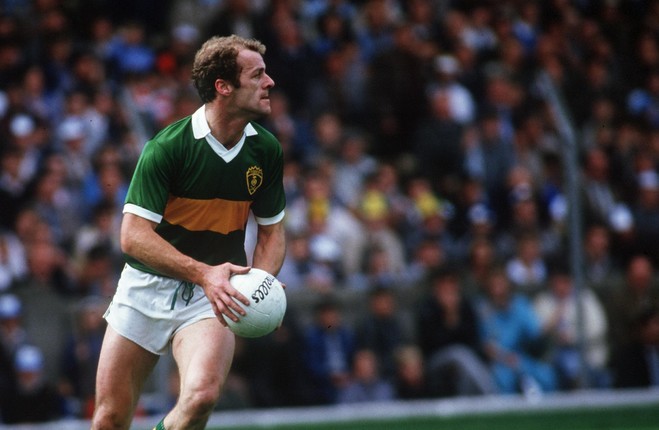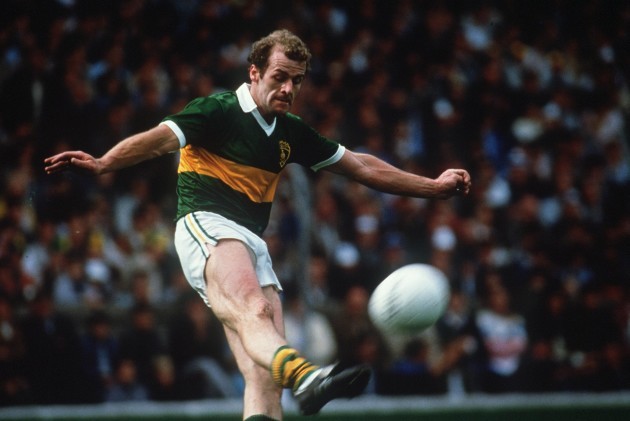JACK O’SHEA IS the seventh subject in our series of articles focusing on the most important Irish sportspeople of the last 100 years. The list will include GAA players, Olympians, boxers, golfers and more who dared to dream.
“When I was young, I heard people talking about the Sheehys (John Joe and sons), Mick O’Connell, Mick O’Dwyer – even great footballers who never won an All-Ireland were not forgotten.
“Every Monday and Tuesday after Kerry played that’s what people talked about.
“We were led to believe that playing for Kerry was the pinnacle of sporting achievement and that was the goal for a young player to aim for.”
If you’re to believe some of the more imaginative local stories, Jack O’Shea was born in Caherceiveen, south Kerry on 19 November 1957 with the sole purpose of taking Kerry football to even greater heights.
With his family home directly across the road from the local GAA pitch, a young O’Shea dreamed of a day when his name would be mentioned in the same breath as the Sheehys, O’Connells and O’Dwyers.
The son of John and Bridie, O’Shea was forced into the workforce at the age of just 13 after his father — a builder — damaged his back and was unable to work. While O’Shea started his working life making packaging for frozen fish, by 1973 a local plumber had offered him an apprenticeship.
At this stage, however, he had already emerged as a special talent on the football pitch with St. Mary’s and his exploits for the club — winners of the South Kerry championships at U12, U14, U16 and minor level — were rewarded with a call up to the Kerry minor set-up in 1974 when he made his Munster championship debut against Waterford.
It would be the following summer before the string-thin teenager really made a name for himself when he claimed both a Munster minor title and an All-Ireland U21 winner’s medal with the Kingdom. He would go on to reach a further three All-Ireland U21 finals, winning two more titles.
He first lined out for the Kerry seniors in the National Football League in 1976, going on to win the competition, and collected a first senior Munster title the following year. He was also involved in that year’s All-Ireland semi-final loss to Dublin, widely regarded as one of the great games in Gaelic football history.
The following year saw a big change for O’Shea as he moved from Kerry to pursue his plumbing career but it was also when the youngster established himself as a permanent fixture in the Kerry senior set-up.
That season, still just 20, the now Leixlip clubman proved to be the linchpin around which one of the all time great teams revolved even though that year’s final is best remembered for Mikey Sheehy’s audacious lob over Paddy Cullen.
It would be the first of seven Celtic Cross medals as Kerry dominated the late 70s and early 80s with no talk at all of splitting the county in two.
While O’Shea proved himself over the next few years as the finest midfielder to ever pull on the green and gold, it would be the decision to pull him back into the half-back line against Offaly in the 1982 final that would cost Kerry an elusive five-in-a-row.
It was the second year in succession the pair had met in the decider and, in 1981, O’Shea’s goal had helped his side to a comfortable seven-point win.
This time, Offaly wouldn’t let the occasion get the better of them and went into the break with an 0-10 to 0-9 lead. The speed and precision of the Offaly attack forced Kerry to use O’Shea as an extra defender which, in turn, allowed the Faithful to win more balls in midfield than most teams were accustomed to.
It was just one of a number of uncharacteristic moves by the Kerry management that day — the other notable mistake being the introduction of a half-fit Pat Spillane — and while much is made of Séamus Darby’s opportunism for the game-winning goal, the entire move stemmed from O’Shea’s absence in midfield.
While Kerry would also miss out on a nine-in-a-row of Munster titles in 1983, the following season they bounced back in some style and, with O’Shea to the fore, dominated the championship for the next three years winning another three Sam Maguires.
O’Shea’s Kerry career would come to an end in 1992, 16 years after it began, with defeat to Clare in the Munster final. He continued to play for Leixlip until 1997 when, at the age of 40, he laced up his boots for the last time in a Leinster Leader Cup Final defeat at the hands of Clane.
In addition to his seven All-Irelands, 10 Munster titles and six All-Stars, O’Shea was named Texaco Footballer of the Year an incredible four times.
But the Kerry star’s real legacy in Gaelic football was to invent his own style of play, one where, even when the opposition knew exactly what he was about to do, very few teams found a way to stop it.
Over the next three months, in association with Allianz Insurance, we’ll be profiling the 16 most important Irish athletes of the last 100 years.
Allianz Insurance — The world belongs to those who dare.


